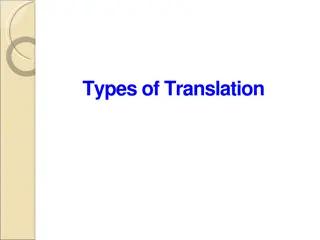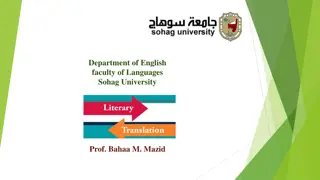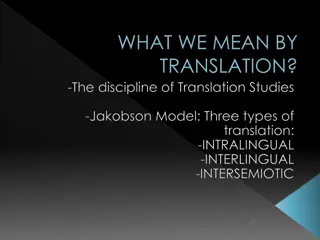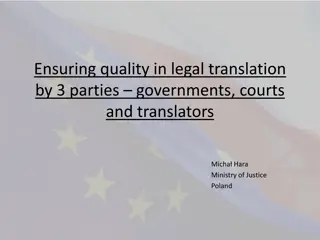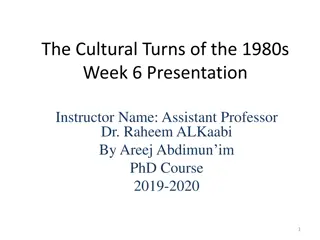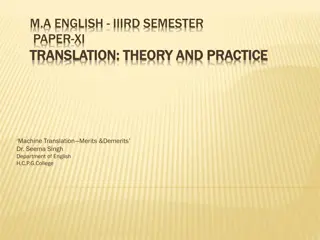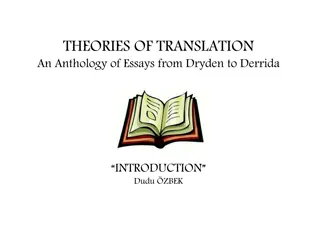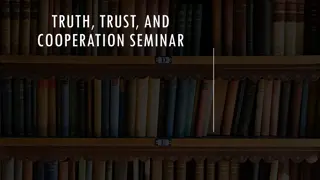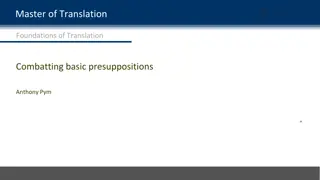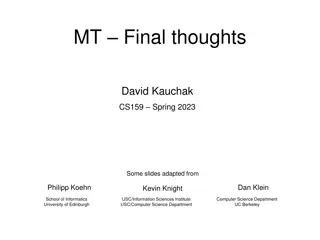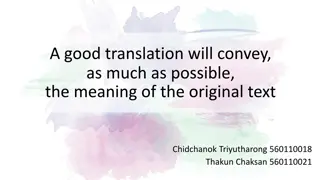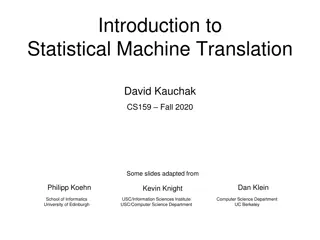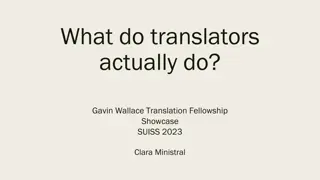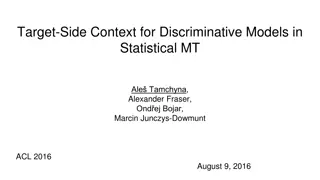Translation Strategies and Principles for Effective Communication
This content covers features and principles of good translation, problems encountered in translation such as lexical and syntactic issues, degrees of approximation, typologies of translation strategies, and the significance of syntactic, semantic, and pragmatic components in translation. It also discusses oblique translation and presents Baker's Taxonomy for a comprehensive understanding of translation strategies. Additionally, it emphasizes the importance of a good translation being easily understood, fluent, idiomatic, and capable of conveying the literary subtleties and cultural contexts of the original text. Three main principles of translation are outlined, focusing on grammar knowledge, vocabulary understanding, reconstitution of text, and capturing the style of the original piece.
Download Presentation

Please find below an Image/Link to download the presentation.
The content on the website is provided AS IS for your information and personal use only. It may not be sold, licensed, or shared on other websites without obtaining consent from the author. Download presentation by click this link. If you encounter any issues during the download, it is possible that the publisher has removed the file from their server.
E N D
Presentation Transcript
TRANSLATION STRATEGIES Yasin K KYILMAZ
CONTENTS I. Features and Principles of Good Translation II. Problems in Translation Lexical Problems Syntactic Problems III. The Degree of Approximation IV. Translation Strategies Typologies V. Translation Strategies Syntactic Semantic Pragmatic VI. Oblique Translation VII. Baker s Taxonomy
I. The Features of Good Translation A good translation; easily understood, fluent and smooth, idiomatic, conveys, to some extent, the literary subtleties of the original, distinguishes between the metaphorical and the literal, reconstructs the cultural/historical context of the original, e.g. Roger as a military term in radio transmission. makes explicit what is implicit in abbreviations, and in allusions to sayings, songs, and nursery rhymes. convey, as much as possible, the meaning of the original text
Three Main Principles of Translation El Shafey (1985) suggests three main principles: The knowledge of the grammar of the source language plus the knowledge of vocabulary, as well as good understanding of the text to be translated. The ability of the translator to reconstitute the given text (source-language text) into the target language. The translation should capture the style or atmosphere of the original text.
II. Problems in Translation A. Lexical Problems In the interpretation of lexical problems, Miremadi (1991) states that, although words are entities that refer to objects or concepts, a word in one language may not be substituted with a word in another language when referring to the same concepts or objects.
Miremadi divides lexical problems into five subcategories: 1. Straight/denotative meaning This kind of meaning refers to those words of the source text that can be matched with those of the target text without missing images 2. Lexical Meaning Lexical meaning refers to words or phrases which seem to be equivalent, although in that situation this may not be the case; the translator must be aware of the intention beyond the misrepresent the author's message. words in order not to
3. Metaphorical Expression This subcategory refers to the problematic issues of translating idioms and similar expressions. Broeik (1981) offers the following suggestions for translating idiomatic expressions: a) Distinguishing between ordinary expressions and metaphors b) Having access to the resources of translating a single metaphor c) Being aware of different contexts and their constraints on using metaphors d) Correctly realizing the constraints on the translation, and rendering the message.
4. Semantic Voids This expressions that represent concepts that cannot be found in other special communities. According to Dr. Miremadi (1991), this may happen in two cases: subjects to extra-linguistic factors such as those words that have referents in a certain speech community but not in others, and subject to intra-linguistic factors such as those concepts that may exist in two language communities but the structure of their use may be completely different. subcategory includes those words and/or
5. Proper Names Although proper names refer to individuals and can be transcribed from one language into another, sometimes the specific meaning that they carry, which do not exist in the target speech community, may be lost. e.g. Geronimo in American culture
B. Syntactic Problems Syntactic problems are the other main category of translation since no two languages have the exact identical systems of structural organizations. These differences include: Word classes: Languages differ from each other in the internal word formation of language classification. Grammatical relations: This difference exists among the languages in the way that a constituent of a sentence functions within that sentence. Word order Style Pragmatic aspects
III. The Degree of Approximation Considering all these problems, a translator is expected to convey the message of the source text to target readers; however, there is no completely exact translation between any two languages;therefore, the degree of approximation between two language effectiveness of the translation. systems determines the
IV. Translation Strategies Typologies According characteristics of translation strategies are as follows: to Chesterman (1997), the general 1. They involve text manipulation. 2. They must be applied to the process. 3. They are goal-oriented. 4. They are problem-centered. 5. They are applied consciously. 6. They are inter-subjective. (It means the strategies must be empirical and understandable for the readers not the person who used them.)
V. Translation Strategies Chesterman's translation strategies is described as follows: (1997) classification of A. Syntactic Strategies B. Semantic Strategies C. Pragmatic Strategies
A. Syntactic Strategies: These local strategies change the grammatical structure of the target text in relation to the source text. Although most of the strategies are applied because a literal translation is not appropriate, Chesterman (1997) presents his first syntactic strategy, literal translation. He believes that, according to many translation theorists, this is a "default" strategy. Syntactic Translation Strategies are as follows:
1. Literal translation: It means the translator follows the source text form as closely as possible without following the source language structure. 2. Loan translation: This is the second syntactic strategy in his classification which refers to the borrowing of single terms and following the structure of the source text which is foreign to the target reader. 3. Transposition: Another term that Chesterman (1997) has borrowed from Vinay and Darbelnet (1958) is transposition that refers to any change in word class, for example adjective to noun. 4. Unit shift: This is a term that has been borrowed from Catford (1965) in the levels of morpheme, word, phrase, clause, sentence and paragraph. 5. Paraphrase structure change: This strategy refers to changes which take place in the internal structure of the noun phrase or verb phrase, although the source language phrase itself maybe translated by a corresponding phrase in the target language.
6. Clause structure change: This is a term which refers to a strategy in which the changes affect the organization of the constituent phrases or clauses. For example, changes from active to passive, finite to infinite 7. Sentence structure change: It is a term that refers to changes in the structure of the sentence unit. 8. Cohesion change: The way in which the parts of a sentence join together to make a fluent, comprehensible sentence is called textual cohesion. Cohesion change is a term referring to a strategy which affects intra-textual cohesion, this kind of strategy mainly takes place in the form of reference by pronouns, ellipsis, substitution or repetition. 9. Level shift: By the term level, Chesterman (1997) means the phonological, morphological, syntactical and lexical levels. These levels are expressed variously in different languages. 10. Scheme change: This strategy is another term in Chesterman's (1997) classification. Parallelism refers to similar arrangement of collocations, phrases or sentences.
B. Semantic Strategies The second group in Chesterman's (1997) classification is semantic strategy which has its own subcategories. Synonymy: In this strategy the translator selects the closest synonym, which is not the first literal translation of the source text word or phrase. Antonymy: In this strategy, the translator uses a word with the opposite meaning. This word mostly combines with a negation. Hyponymy: It means using a member of larger category (e.g. rose is a hyponym in relation to flower), and also hypernym is a related superordinate term, which describes the entire category with a broader term (e.g. flower is a hypernym in relation to rose). Converses: This strategy refers to pairs of opposites expressing similar semantic relationships from the opposite perspectives (e.g. send-receive, take-give).
Trope change: The formal name that is used for a figure of speech or metaphor is called trope which means using a term or phrase to compare two things that are unrelated with the purpose of revealing their similarity. This relates to a type of strategy called trope change strategy. Abstraction change: The other kind of strategy in the list is abstraction change. This strategy concerns shifting either from more abstract terms to more concrete ones or vice versa. Distribution change: This is a kind of strategy in which the same semantic component is distributed over more items (expansion) or fewer ones (compression). Emphasis change: This strategy increases, decreases or changes the emphasis of thematic focus of the translated text in comparison to the original. Paraphrase strategy: This is the last strategy in the list. According to the overall meaning of the source text, it creates a liberal approximate translation, some lexical items may be ignored in this sort of strategy.
C. Pragmatic Strategies Cultural filtering: It may be described as the concrete realization, at the level of language, of the universal strategy of domestication or target culture-oriented translation. This strategy is generally used while translating culture-bound items. Explicitness change: In explicitness information of the source text maybe added; or deleted to make the text more or less explicit. Information change: It is similar to the previous strategy; however, here the changed information is NOT implicit in the source language text. Interpersonal change: This strategy is used to affect the whole style of the text to make it more or less informed, technical etc. Speech act: There is another strategy the changes the nature of the source text speech act, either obligatory or non-obligatory (e.g. from reporting to a command, or from direct to indirect speech). change strategy some
Visibility change: This is a strategy that increases the "presence" of either the author of the source text or its translator (e.g. footnotes that are added by the translator). Coherence change: It concerns a higher textual level (i.e. combining different paragraphs to each other in a way different from the source text). Partial translation: This is a strategy that refers to translating a part of a text, not the entire text (e.g. song lyrics or poetry). Trans-editing: According to Stetting (1989), another strategy which can be mentioned in this section is trans-editing that refers to extensive editing of the original text when necessary (i.e. changing the organization of the source text information, wording etc).
VI. Oblique Translation When literal translation is not possible because of lexical and syntactical differences between the two languages, oblique translation is used. Oblique translation includes seven subcategories which are as follows: Borrowing: that is used to tackle a meta-linguistic difference. It is the simplest strategy of translation that means using source language terms in the target text ( deja vu, buon appetit ) Calque: This is a special type of borrowing in which the borrowed expression is literally translated into the target language. ( Skyscraper=G kdelen) Literal translation: that means rendering a source language text into the appropriate idiomatic or grammatical equivalent in the target language.
Transposition: That is substituting one word class with another without changing the meaning of the message. Modulation: this means changing in point of view (e.g. changing part of speech). Equivalence: This refers to rendering two situations by different stylistic and structural methods; these two texts include the source text and its equivalent text which is the target text. Adaptation: That refers to those situations when cultural differences occur between the source language and the target language. Thus, translation can be considered as a special kind of equivalence which is situational equivalence.
VII. Bakers Taxonomy Mona Baker (1992) lists eight strategies, which have been used by professional translators, to cope with the problematic issues while doing a translation task: Translation by a more general word This is one of the most common strategies to deal with many types of nonequivalence. As Baker believes, it works appropriately in most, if not all, languages, because in the semantic field, meaning is not language dependent. Translation by a more neutral/less expressive word This is another strategy in the semantic field of structure.
Translation by cultural substitution This strategy involves replacing a culture-specific item or expression with a target language item considering its impact on the target reader. This strategy makes the translated text more natural, more understandable and more familiar to the target reader. Translation using a loan word or loan word plus explanation This strategy is usually used in dealing with culture-specific items, modern concepts, and buzz words. Using the loan word with an explanation is very useful when a word is repeated several times in the text. At the first time the word is mentioned by the explanation and in the next times the word can be used by its own.
Translation by paraphrase using a related word This strategy is used when the source item in lexicalized in the target language but in a different form, and when the frequency with which a certain form is used in the source text is obviously higher than it would be natural in the target language. Translation by paraphrase using unrelated words The paraphrase strategy can be used when the concept in the source item is not lexicalized in the target language. When the meaning of the source item is complex in the target language, the paraphrase strategy may be used instead of using related words; it may be based on modifying a super-ordinate or simply on making clear the meaning of the source item.
Translation by omission This may be a drastic kind of strategy, but in fact it may be even useful to omit translating a word or expression in some contexts. If the meaning conveyed by a particular item or expression is not necessary to mention in the understanding of the translation, translators use this strategy to avoid lengthy explanations. Translation by illustration This strategy can be useful when the target equivalent item does not cover some aspects of the source item and the equivalent item refers to a physical entity which can be illustrated, particularly in order to avoid over-explanation and to be concise and to the point.





